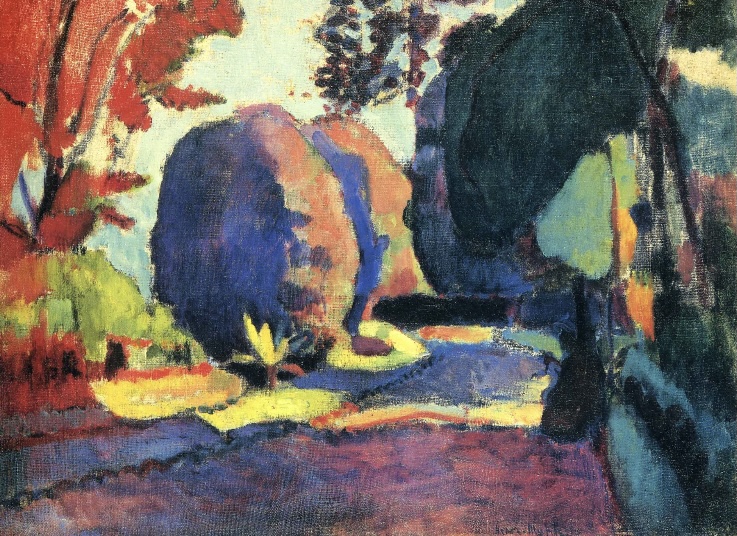Featured
- Get link
- X
- Other Apps
Henri Matisse 2. Woman with a hat - a drawing of the fauve for his wife
The Drawing of the Beast for his Wife
Henri Matisse, Woman (Amelie Noelie Parayre) with a hat (1905)
-------------------------------------------------
During his visit to the French island of Belle, Henri Matisse found himself deeply inspired by the vibrant colors of the surroundings. However, his artistic direction was momentarily swayed back to tradition due to criticism from his teacher. It wasn't until his teacher's passing that Matisse found the freedom to explore new styles in his painting journey. This opportunity for artistic growth coincided with his marriage and honeymoon.
In the 19th century, it was quite common for painters to have relationships with their models. Despite facing challenges like lack of support and financial constraints, Matisse continued to pursue his art, finding inspiration in his models. Matisse had a daughter named Marguerite, born to him and Amélie Parayre, not Carolyn Caroline Joblau as commonly assumed.
Compared to Picasso's more controversial relationships, Matisse's demeanor was considered more refined. However, having a daughter out of wedlock was still a taboo in 19th-century society.
Amélie Parayre, understanding Matisse's circumstances, accepted Marguerite as her own. Marguerite was eventually adopted, and Amélie went on to have two sons, Jean and Pierre.
In 1898, Henri Matisse and his wife embarked on a honeymoon to Corsica, located in southern France. It was during this trip that Matisse found himself immersed in the vivid colors of the region: the azure sky, golden grains, and lush green foliage. These vibrant hues reminded him of the sensory feast he experienced on his previous visit to Belle Island. It was here, amidst the splendor of southern France, that Matisse's artistic style began to evolve away from tradition.
Upon their return to Paris, Matisse's newfound appreciation for color was further ignited. He began to collect paintings by artists such as Van Gogh, Gauguin, and Cezanne, all of whom had made a strong impression on him with their bold and innovative use of color. This exposure to their works further inspired Matisse to push the boundaries of his own painting style.
Henri Matisse found himself in financial hardship after spending all his money on collecting paintings. Without the funds to purchase paints, he was unable to pursue his own artistic endeavors for several years. To make ends meet, he took on work as an assistant to Albert Marquette.
During this period, Matisse delved into the writings of Paul Signac and became captivated by the technique of pointillism. He was drawn to the charm and intricacy of creating images using tiny dots of color. This technique, also known as divisionism, appealed to Matisse's sense of experimentation and allowed him to explore new ways of depicting light and color in his paintings.
Over the years, Matisse honed his skills in pointillism and produced numerous artworks using this technique. While he eventually moved away from strict pointillism towards his own unique style, the influence of this period remained evident in his later works through his mastery of color and light.
Still life with a Purro (1904)
Drawing inspiration from secessionism and the vibrant color palettes of artists like Van Gogh, Gauguin, and Cezanne, Henri Matisse crafted his own unique style. His approach was more than just dots on a canvas; it was a fusion of techniques and influences.
Incorporating the intense hues reminiscent of Van Gogh's works, Matisse employed colors in a diverse and expressive manner. Yet, his style was not merely about complexity; he sought simplicity akin to the works of Gauguin and Cezanne. Through careful consideration and synthesis of these influences, Matisse's distinctive painting style emerged, offering a harmonious blend of intensity and simplicity to the world.
In Matisse's depiction, Amélie, his supportive wife, takes center stage, portrayed with gratitude for her role in sustaining him through her hat-making and repair skills. However, when the painting was unveiled to the public, it elicited laughter from many.
Renowned critic Louis Vauxcelles, known for his acerbic critiques, remarked that the colors appeared too dispersed, likening the piece to a wild beast's chaotic creation. Despite initial criticism, Matisse's bold use of color and unconventional style would eventually redefine artistic norms and pave the way for the Fauvist movement.
Isn't it ironic that the term "Fauvism" actually originated from a critic's description of these artists' work as "wild beasts"? Poor Henri... His ambition to innovate ended up being ridiculed instead of appreciated as he had hoped. It makes you wonder, why did they laugh? And what about the paintings that were highly regarded during that time? That's exactly what crossed my mind, prompting me to delve into some research.
Ah, look at this exquisite piece—it's so intricate, lifelike, and utterly captivating. This painting is by Gustave Moreau, Henri's mentor. I can almost imagine Moreau teasing Henri, saying something like, "Henri... Was it a bit tedious for you to draw?"
Updated in 2024.05.23
Popular Posts
Vincent Van Gogh 6. Settling in Arles, Establishing the Foundations of Impressionism
- Get link
- X
- Other Apps









